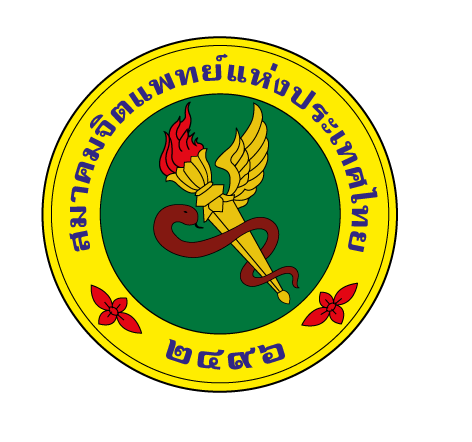ลักษณะของผู้ป่วยที่กินยาพาราเซตามอลเกินขนาดและปัจจัยเสี่ยงต่อภาวะเป็นพิษต่อตับรุนแรง
Main Article Content
บทคัดย่อ
วัตถุประสงค์ เพื่อศึกษาลักษณะข้อมูลทั่วไป และปัจจัยเสี่ยงที่มีผลเกี่ยวข้องต่อภาวะเป็นพิษต่อตับรุนแรง
ในผู้ป่วยที่กินยาพาราเซตามอลเกินขนาดที่มารับการรักษาที่โรงพยาบาลรามาธิบดี ระหว่างปี พ.ศ.2550-
พ.ศ.2559
วิธีการศึกษา เป็นการศึกษาเชิงพรรณนาแบบย้อนหลัง โดยเก็บข้อมูลจากผู้ป่วยนอกและผู้ป่วยในของ
โรงพยาบาลรามาธิบดี ที่ได้รับการวินิจฉัยว่า “กินยาพาราเซตามอลเกินขนาด” (ICD-10: T391) ในช่วงเวลา
ระหว่าง 1 มกราคม พ.ศ. 2550 ถึง 31 ธันวาคม พ.ศ. 2559
ผลการศึกษา ผู้ป่วยที่ได้รับการวินิจฉัยว่ากินยาพาราเซตามอลเกินขนาดระหว่างปี พ.ศ. 2550-2559
มีจำนวน 105 ราย ส่วนใหญ่เป็นเพศหญิง ช่วงอายุระหว่าง 21-39 ปี มีสถานภาพโสด แยกกันอยู่หรือหย่าร้าง
อาชีพนักเรียน/นักศึกษา และการศึกษาระดับปริญญาตรีหรือสูงกว่า แรงจูงใจที่พบบ่อยคือเพื่อฆ่าตัวตาย/
ทำร้ายตัวเอง (ร้อยละ 49.42) สาเหตุที่พบบ่อยคือปัญหาความสัมพันธ์ (ร้อยละ 67.44) ผู้ป่วยส่วนใหญ่
มีประวัติการฆ่าตัวตายมาก่อน (ร้อยละ 66.67) ไม่มีประวัติความเจ็บป่วยทางจิตเวชเดิมมาก่อน (ร้อยละ
84.95) ลักษณะการกินยาเป็นแบบหุนหันพลันแล่น (ร้อยละ 91.95) ได้รับวินิจฉัยเป็นภาวะการปรับตัวที่
ผิดปกติมากที่สุด (ร้อยละ 58.25) ค่า AST, ALT, PT, PTT, INR สามารถบ่งชี้ถึงภาวะเป็นพิษต่อตับรุนแรง
ได้ ขณะที่ค่า ALP ไม่สามารถบ่งชี้ถึงภาวะเป็นพิษต่อตับรุนแรงได้ ระดับยาพาราเซตามอลไม่สัมพันธ์กับ
ความรุนแรงของภาวะเป็นพิษต่อตับ ปัจจัยเสี่ยงสำคัญต่อการเกิดภาวะเป็นพิษต่อตับรุนแรงคือ ระยะเวลา
หลังกินยาพาราเซตามอลแล้วเข้ามารับการรักษาที่ห้องฉุกเฉิน โดยผู้ป่วยที่มารับการรักษานานเกิน 8 ชั่วโมง
หลังกินยาพาราเซตามอลจะมีความเสี่ยงต่อการเกิดภาวะเป็นพิษต่อตับรุนแรง 20.9 เท่าของผู้ป่วยที่มารับ
การรักษาเร็วกว่า 8 ชั่วโมง (95% CI 5.476-79.682, p < 0.001). ผู้ป่วยที่มีภาวะเป็นพิษต่อตับรุนแรงจะใช้
เวลารักษาในโรงพยาบาลนานกว่ากลุ่มที่ไม่มีภาวะเป็นพิษต่อตับรุนแรงอย่างมีนัยสำคัญทางสถิติ
สรุป การกินยาพาราเซตามอลเกินขนาดส่วนใหญ่เป็นการกระทำแบบหุนหันพลันแล่น และผลกระทบจะ
ไม่มากหากผู้ป่วยเข้ารับการรักษาเร็ว จึงควรส่งเสริมให้สังคมตระหนักถึงความความสำคัญของการเข้ารับ
การรักษาที่โรงพยาบาลโดยเร็วภายหลังการกินยาพาราเซตามอลเกินขนาด ซึ่งจะช่วยลดความเสี่ยงต่อ
การเกิดภาวะเป็นพิษต่อตับรุนแรง และลดภาระทรัพยากรทั้งค่าใช้จ่าย เวลา และบุคลากรทางการแพทย์
Article Details
บทความที่ส่งมาเพื่อพิจารณา ต้องไม่เคยตีพิมพ์หรือได้รับการตอบรับให้ตีพิมพ์ในวารสารฉบับอื่น และต้องไม่อยู่ระหว่างการส่งไปพิจารณาในวารสารอื่น
เอกสารอ้างอิง
World Health Organization. Suicidal data 2018. 2018 [cited 15 December 2018]. [Available from: https://www.who.int/mental_health/ prevention/suicide/suicideprevent/en/
Department of Mental Health, Ministry of Public Health. Suicide rate per 1000,000 populations 2016. 2016 [cited 15 December 2018]. Available from: https://www.dmh.go.th/report/suicide/ download/view.asp?id=170
Ajdacic-Gross V, Weiss MG, Ring M, Hepp U, Bopp M, Gutzwiller F, et al. Methods of suicide: international suicide patterns derived from the WHO mortality database. Bull World Health Organ 2008; 86: 726-32.
Elnour AA, Harrison J. Lethality of suicide methods. Inj Prev 2008;14:39-45.
Williams SC, Schmaltz SP, Castro GM, Baker DW. Incidence and Method of Suicide in Hospitals in the United States. Jt Comm J Qual Patient Saf 2018; 44: 643-50.
Kolves K, McDonough M, Crompton D, de Leo D. Choice of a suicide method: Trends and characteristics. Psychiatry Res 2018; 260: 67-74.
Aguilera P, Garrido M, Lessard E, Swanson J, Mallon WK, Saldias F, et al. Medication overdoses at a public emergency department in Santiago, Chile. West J Emerg Med 2016; 17: 75-80.
Manthripragada AD, Zhou EH, Budnitz DS, Lovegrove MC, Willy ME. Characterization of acetaminophen overdose-related emergency department visits and hospitalizations in the United States. Pharmacoepidemiol Drug Saf 2011; 20: 819-26.
Kapur N, Turnbull P, Hawton K, Simkin S, Sutton L, Mackway-Jones K, et al. Self-poisoning suicides in England: a multicentre study. QJM 2005; 98: 589-97.
El Majzoub I, El Khuri C, Hajjar K, Bou Chebl R, Talih F, Makki M, et al. Characteristics of patients presenting post-suicide attempt to an Academic Medical Center Emergency Department in Lebanon. Ann Gen Psychiatry 2018; 17: 21.
Kweon YS, Hwang S, Yeon B, Choi KH, Oh Y, Lee HK, et al. Characteristics of drug overdose in young suicide attempters. Clin Psychopharmacol Neurosci 2012; 10: 180-4.
Gazzard BG, Davis M, Spooner J, Williams R. Why do people use paracetamol for suicide? Br Med J 1976; 1: 212-3.
Gazzard BG, Davis M, Spooner JB, Williams RS. Why paracetamol? J Int Med Res 1976; 4: 25-8.
Gunnell D, Murray V, Hawton K. Use of paracetamol (acetaminophen) for suicide and nonfatal poisoning: worldwide patterns of use and misuse. Suicide Life Threat Behav 2000; 30: 313-26.
Hawton K, Bergen H, Simkin S, Arensman E, Corcoran P, Cooper J, et al. Impact of different pack sizes of paracetamol in the United Kingdom and Ireland on intentional overdoses: a comparative study. BMC Public Health 2011; 11: 460.
Hawton K, Townsend E, Deeks J, Appleby L, Gunnell D, Bennewith O, et al. Effects of legislation restricting pack sizes of paracetamol and salicylate on self poisoning in the United Kingdom: before and after study. BMJ 2001; 322: 1203-7.
Sarchiapone M, Mandelli L, Iosue M, Andrisano C, Roy A. Controlling access to suicide means. Int J Environ Res Public Health 2011; 8: 4550-62.
Krenzelok EP. The FDA Acetaminophen Advisory Committee Meeting - what is the future of acetaminophen in the United States? The perspective of a committee member. Clin Toxicol (Phila) 2009; 47: 784-9.
Gulmez SE, Larrey D, Pageaux GP, Bernuau J, Bissoli F, Horsmans Y, et al. Liver transplant associated with paracetamol overdose: results from the seven-country SALT study. Br J Clin Pharmacol 2015; 80: 599-606.
Yoon E, Babar A, Choudhary M, Kutner M, Pyrsopoulos N. Acetaminophen-Induced hepatotoxicity: a comprehensive update. J Clin Transl Hepatol 2016;4:131-42.
Suppapitiporn S, Suppapitiporn S. Attempted suicide by acetaminophen ingestion. Chulalongkorn Medical Journal 2003; 47: 713-25.
Narongchai P, Narongchai S. Paracetamol overdose in suicidal attempt patients. J Med Assoc Thai 2004; 87: 423-6.
Chatchaichukiat P. Characteristic of in-patient of paracetamol overdose in ramathibodi hospital [Dissertation]. Bangkok: Ramathibodi Hospital, Mahidol University; 2006.
Schmidt LE. Age and paracetamol self-poisoning. Gut 2005; 54: 686-90.
Gyamlani GG, Parikh CR. Acetaminophen toxicity: suicidal vs. accidental. Crit Care 2002; 6: 155-9.
Kweon YS, Hwang S, Yeon B, Choi KH, Oh Y, Lee HK, Lee CT, Lee KU. Characteristics of drug overdose in young suicide attempers. Clin Psychopharmacol Neurosci 2012; 10: 180-4.
Hawton KW, Mistry H, Hewitt J, Kingsbury S, Roberts D, Weitzel H. Paracetamol self-poisoning characteristics, prevention and harm reduction. Br J Psychiatry 1996; 168: 43-8.
Iqbal M, Cash WJ, Sarwar S, McCormick PA. Paracetamol overdose: the liver unit perspective. Ir J Med Sci 2012; 181: 439-43.
Sheen CL, Dillon JF, Bateman DN, Simpson KJ, Macdonald TM. Paracetamol toxicity: epidemiology, prevention and costs to the health-care system. QJM 2002; 95: 609-19.
O’Rourke M, Garland MR, McCormick PA. Ease of access is a principal factor in the frequency of paracetamol overdose. Irish journal of medical science 2002; 171: 148-50.
Giannini EG, Testa R, Savarino V. Liver enzyme alteration: a guide for clinicians. CMAJ 2005; 172: 367-79.
Palta S, Saroa R, Palta A. Overview of the coagulation system. Indian J Anaesth 2014; 58: 515-23.

